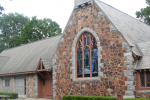May 16, 2024
What if the Best Use of Our Buildings is to Give Them Away?
This is the first post in a two-part series. The second part can be found here.

Church of the Ascension in Lexington Park, Maryland owned a house next door to the church. It was never the rectory. It was given to the church in 2000. For many years, Ascension rented it to a local transitional living shelter. The congregation, as landlords, managed and maintained the property as well as they could – but it wasn’t a well-built home in the first place, having been thrown up fairly inexpensively along with all the other homes in that post-WW2 neighborhood in the late 1940s. Having a constant turnover of residents as well as a shelter serving as tenant also posed ongoing challenges, but the church was serving the needs of the neighborhood. Sure, there were annual property tax payments and maintenance costs but, still, the $1,700 rent check each month was nice for the congregation’s cash flow.
When Ascension entered into a yoking relationship with St. George’s Episcopal Church in nearby Valley Lee, there was little talk about what to do about the house. Few leaders wanted to keep it, considering the demands and maintenance, but they also didn’t want to sell it to a property developer who’d flip the property. But, mostly, they also didn’t want to walk away from that monthly rent check. Yoking meant that each church still maintained separate and distinct budgets, so no one could precisely see economies of scale and potential long-term savings.
A very cold winter in 2018 left frozen pipes and significant water damage, and the congregation invested nearly $96,000 in the house that was worth at the time barely $150,000. That’s how much they valued the neighborhood and the mission of that house. That renovation put the house in far better shape than it ever was – a whole house drain was installed all the way down to the foundation; new electrical systems and HVAC – but the house still cost maintenance and dollars and time. In time, the shelter told us they didn’t intend to renew their lease. Monthly rent had risen to $2,000 but, still, the consensus was to sell it.
But the good news is two-fold, well, three-fold if you keep reading to the end of this post.
First, by the time Church of the Ascension’s leadership finally determined to sell the house – which they’d wanted to do almost since the day they were given the house – it was no longer one standalone church. Ascension was now the Lexington Park campus of Resurrection Parish, the Diocese of Washington’s newest parish: a multi-site ministry between Lexington Park and Valley Lee in St. Mary’s County, MD. The new parish’s single vestry and leadership team were already realizing vast savings and seeing greater and greater economies of scale. Ascension already gained a rectory by merging with St. George’s (St. George’s had a rectory), and costs were lower because both congregations were pulling 100% together. Selling a piece of property was now not only desirable but also achievable.
Second, to offset the cash flow deficit posted by the rental income, the parish looked into renewal sources of energy, ultimately focusing on solar. Did you know that the Inflation Reduction Act now gives federal and state cash rebates to tax-exempt organizations, such as churches, who install solar panels? Churches were never eligible for solar tax incentives because, well, we didn’t pay taxes. Now that’s no longer the case.
A local solar company examined the physical footprint of both Ascension and St. George’s, and realized that solar panels placed in Valley Lee would generate nearly 118% of total electrical power. (It’d only be about 85% if placed at Ascension.) I know you get the point, but let me drive it home very plainly: the sale of a property formerly owned by Ascension led to installing solar panels at St. George’s – which was previously a separate parish – but because both churches had fully merged into one parish the solar project amplified the total savings from renewable energy and reduced total utilities cost to both churches. Turns out, full institutional collaboration is not only good for the bottom line, but it helps congregations take on the hard decisions they’ve long wanted to do (but couldn’t for all kinds of reasons, cash flow often among them) and invest in more sustainable, environmentally friendly sources of energy conservation.
Oh, and the rebates generated by the solar project at St. George’s will go entirely to fund newer, more energy-efficient HVAC systems at Ascension, thus getting rid of the old gas-guzzling 1960s systems and bringing down Ascension’s utility bills to a more manageable price point. Again, collaboration isn’t only about sharing programs or ministries or pulpit swaps. Dive deep and your church will come out far stronger and much healthier, in all kinds of ways.
But back to that house, and the third bit of good news I promised.
One of our values in holding on to that house was our connection with the neighborhood. Ascension is a neighborhood church, through and through, although the neighborhood and the church hadn’t seen eye-to-eye for a number of decades. But the house’s driveway was the literal footpath throughway in and out of the neighborhood, and it helped bring folks into our common life in meaningful and, over the last several years, quite friendly ways. That was one of the bigger sticking points to selling the house. We didn’t want to lose our connection with our neighbors.
A local couple purchased the property, which ended at the back of the garage, and then asked our real estate agent about “the triangle.” You see, there’s a triangle-shaped bit of land between the back of the house lot and our parking lot. The church owned The Triangle. No one wanted to mow it or keep it, so we gave it to the purchasers.
And here’s where Good News point 3 begins: it turns out that The Triangle is zoned mixed-use commercial, whereas the house, of course, is residential. Being smart young attorneys, the new owners realized they had an opportunity to diversify their new investment and open a business on their new commercial property. Feeling drawn to the underserved, struggling (but beautiful and diverse and deeply connected) community that is downtown Lexington Park, the new owners opened the Patuxent Harvest Market+ -- a market shop that brings fresh, affordable produce to the heart of Lexington Park, along with pick-your-own vegetable / herb gardens and beautiful hanging plants and a desire to offer movie nights and other social events on The Triangle, of course spilling over into the church parking lot. We’ve been in early conversations with the new owners about welcoming them as formal partners in the work we’re doing with our other partners (see my other posts about the Park Community Partnership). By partnering with our new neighbors and their new start-up business, Church of the Ascension is even more deeply engaged in our commitment to reach and serve and befriend our neighbors as neighbors – and all because we sold the property we had.
What if the best way to serve our neighbors and neighborhoods is, in fact, to give away and sell our property? What if the Lord has such goodness built up and stored that, in some strategic places, our response should be getting out of the way and partnering with what’s new?





